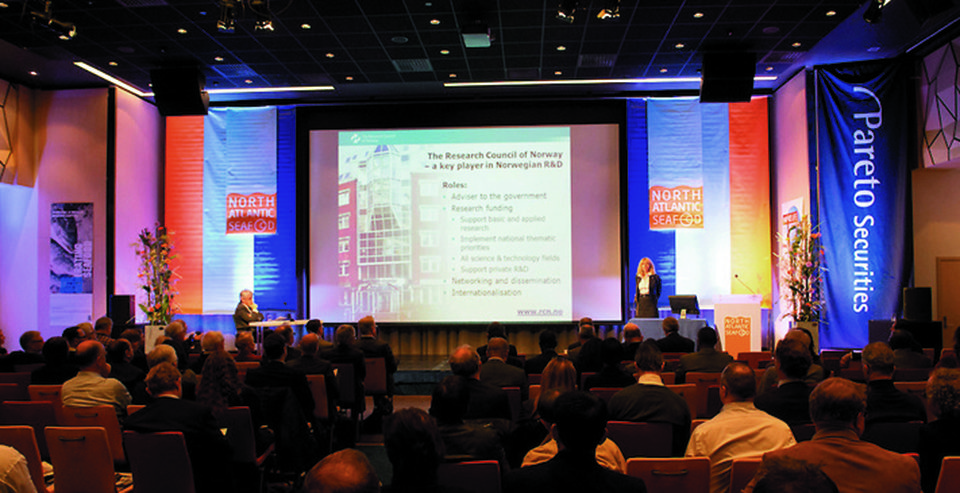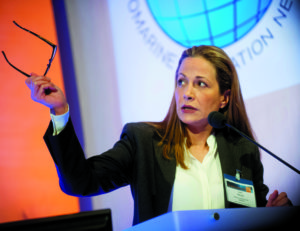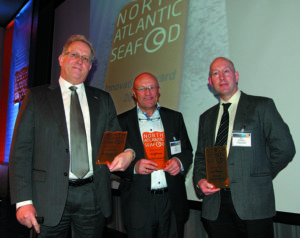North Atlantic forum examines sustainable aquaculture growth

The North Atlantic Seafood Forum (NASF) drew major stakeholders and key players to Bergen, Norway, to review the status of global aquaculture and examine the pathways and innovations needed to sustainably expand the sector manyfold. Serious engagement by 200 manufacturers, solution providers, financiers, public authorities, consumer groups and non-governmental organizations made NASF a vibrant event in the spirit of shaping the future of aquaculture.
On Marine Innovation Day, March 5, presentations by expert speakers combined with an awards program and innovative “think tank” sessions in contributing to the knowledge of the participants and organizers.
Informative speakers
In opening the forum, Christina Abildgaard, director of the Research Council of Norway, pointed out the immense untapped potential of the world’s “blue” resources, and, as expressed by World Bank Group, its emerging importance for the world economy. She presented data on how state-of-the-art research and development have led to breakthroughs in improved cost efficiency, productivity and sustainability in global aquaculture.
Dr. George Chamberlain, president of the Global Aquaculture Alliance, gave an opening keynote on innovations needed to overcome the challenges constraining aquaculture growth.
Chamberlain said that rising global demand for seafood is largely driven by the global economy’s “shifting center of gravity,” as the growing middle class in Asia and elsewhere can now buy more seafood. Producers of shrimp and fish are seeking improved technologies for genetic enhancement, optimized feeding, disease control and infrastructure management.
Genetics represent a major driver for enhanced productivity, Chamberlain said.
Dr. Lara Barazi, chief executive officer of Kefalonia Fisheries, presented “Temperate Water Aquaculture – Potentials, Challenges and Solutions as a Future Key Global Food Supplier.”
Barazi focused on the Mediterranean aquaculture sector, which has experienced dynamic growth over the past 30 years, but is still far from reaching its potential. The same elements that contributed to past growth – the recognized health benefits of fish together with the positive image of the Mediterranean diet and oceanographic and climatic characteristics of the region – will continue to do so, she said.
But to make the industry more competitive and viable, research into species diversification, genetics, disease prevention, feed quality, efficiency and sustainability must be encouraged. Better data, management and planning will help smooth out the volatility that has largely hampered its development so far.

Odd Magne Rødseth, chief executive officer of Aqua Gen A.S., spoke on the future contributions of cold water aquaculture to the global food supply. Rodseth said that in 2010, production of Atlantic salmon and rainbow trout, the main fish species raised in cold water regions, reached 2.5 million metric tons (MT) – about 6 percent of the global farmed fish production.
These cold-water carnivores’ dependence upon finite capture fisheries as their major source for dietary protein and lipids has led to intensive research programs to find alternatives to fish oils. The most promising efforts include production of long-chain omega-3 fatty acids by yeast fermentation, extraction from algal sources or genetic modification of oilseed crops.
To counter the impacts of infectious diseases, scientists and industry have developed new technologies and management strategies based on better understanding of the genetic and physiological basis of immunity and disease resistance.
Dr. Doris Soto of the United Nations Food and Agriculture Organization (FAO) Fisheries and Aquaculture Department gave a plenary keynote on FAO’s efforts to promote a global sustainable aquaculture agenda and an ecosystem approach to aquaculture.
Soto said the main challenges to aquaculture growth include land and water availability, cost and energy-efficient productivity, ecosystem impacts, feed issues, biosecurity and health, finance and investment, and social impacts. FAO is assisting member countries with policies and planning, certification guidelines and compliance assessment, dissemination of investment tools for small farmers, and improvements in feeds, biosecurity and genetics.
Throughout, FAO promotes an ecosystem approach to aquaculture that emphasizes site zoning and locating that consider the social, economic, environmental and governance aspects of projects.
Innovation awards
To highlight potential innovative and powerful aquaculture solutions, the Marine Innovation Day launched three awards. The 17 entries included ideas for biorefining chitin, lysis-based mussel meat production and even an optical-based system for sea lice treatment.
The award for Best Invention went to OxySolutions, which has developed and patented a radical new method for oxygenation of water. The technology can increase the amount of oxygen in water up to 1,000 percent under normal room temperature and pressure. This bubble-free solution makes it possible to oxygenate large tanks or recirculating facilities to the desired level based on fish type. This enhances food uptake, fish health and growth.
Under Best Solution, the award winner was Hortimare for its system to produce kelp, a valuable source of marine protein that is rich in essential amino acids, to be used in fish feed. Kelps cultivated near fish farms can use the valuable nutrients coming from the farms and bio-remediate the sea at the same time. This results in a more stable ecosystem and less pressure on worldwide fish catches for fishmeal.
The Best Innovation selection examined system integrations of known innovations. The award winner was Novartis Animal Health for its work on nucleic acid vaccine technology for fish. This novel biomedical technology offers distinct advantages over conventional immunization or chemotherapy.
Think tanks

Ahead of the conference, experienced chairs for seven “think tank” sessions outlined main issues upon which to guide the workshop sessions. The intense discussions that took place during the brief parallel sessions yielded interesting directives.
The “Race for Space” session sent one clear message: We need major innovations to find and utilize optimal sites for long-term, efficient aquaculture production. Where are the “super sites,” and how can they be utilized in a sustainable manner?
Under “Science and Technology,” the species question was debated. Session participants agreed that five species groups – salmonids, cyprinids, catfish, bass/bream and shrimp – will be the most likely contributors to aquaculture industry growth. To really contribute to food production, they said, innovations are needed to cut the time from egg to market by 50 percent.
“Brains, Money and Dialogue” focused on the need for aquaculture to become a major knowledge-based industry globally to attract talented young people. Related to this, “Engineering and Gear Solutions” discussed innovations for intelligent technology – the need for technologies that work perfectly, independent of human operating mistakes.
In “Human Health and Seafood” the importance of seafood as healthy food was addressed, along with the need for completely new sources of raw materials for feed. This was echoed in “Existing and New Bioresources,” which called for the development of fully integrated systems for balanced, ecosystem-based harvesting and total utilization of all the catch.
From the “Market Innovation” thinkers, the concept of Total Brand Management together with a strengthened market orientation among the players came out as essential for further development and value creation.
Vision paper
An international work group chaired by co-author Kjell Maroni is developing a vision paper focused on the major innovative breakthroughs needed to expand global aquaculture significantly. The group collected substantial inspiration and inputs from the forum program.
While still under development, the vision paper will likely address important components of the carbon footprint of the sector, as well as sustainable feed supplies, enhanced farming predictability through powerful disease control systems and accompanying regimes to manage environmental and wild stock impacts. Additional elements will focus on the recruitment of human capital, communications and market innovations.
(Editor’s Note: This article was originally published in the May/June 2013 print edition of the Global Aquaculture Advocate.)
Authors
-
Øystein Lie
Executive Manager, MareLife
Gaustadalléen 21
N-0349 Oslo, Norway[103,114,111,46,101,102,105,108,101,114,97,109,64,101,105,108,46,110,105,101,116,115,121,111]
-
Kjell Maroni
R & D Director, Norwegian Seafood Research Fund
President, European Aquaculture Society
Tagged With
Related Posts

Responsibility
A look at unit processes in RAS systems
The ability to maintain adequate oxygen levels can be a limiting factor in carrying capacities for RAS. The amount of oxygen required is largely dictated by the feed rate and length of time waste solids remain within the systems.

Responsibility
Addressing safety in Latin America’s tilapia supply chain
Over the last decade, the experience gained by many tilapia farmers combined with proficient programs implemented by local governments have significantly improved tilapia production in various Latin American countries like Colombia, Mexico, Ecuador and other important tilapia producers in the region.

Intelligence
A land grab for salmon (and shrimp) in upstate New York
The operators of Hudson Valley Fish Farm see their inland locale as a pilot to prove that land-based fish farming, located in close proximity to major metropolitan markets, can be successful.

Health & Welfare
A look at tilapia aquaculture in Ghana
Aquaculture in Ghana has overcome its historic fits and starts and is helping to narrow the gap between domestic seafood production and consumption. Production is based on Nile tilapia.


